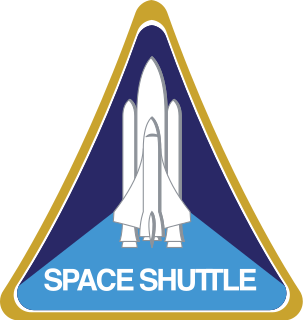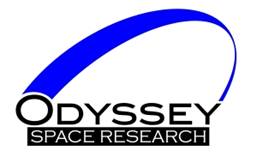
The Space Shuttle program was the fourth human spaceflight program carried out by the National Aeronautics and Space Administration (NASA), which accomplished routine transportation for Earth-to-orbit crew and cargo from 1981 to 2011. Its official name, Space Transportation System (STS), was taken from a 1969 plan for a system of reusable spacecraft of which it was the only item funded for development.

The Constellation Program is a cancelled crewed spaceflight program developed by NASA, the space agency of the United States, from 2005 to 2009. The major goals of the program were "completion of the International Space Station" and a "return to the Moon no later than 2020" with a crewed flight to the planet Mars as the ultimate goal. The program's logo reflected the three stages of the program: the Earth (ISS), the Moon, and finally Mars—while the Mars goal also found expression in the name given to the program's booster rockets: Ares. The technological aims of the program included the regaining of significant astronaut experience beyond low Earth orbit and the development of technologies necessary to enable sustained human presence on other planetary bodies.

The Lockheed Martin X-33 was an uncrewed, sub-scale technology demonstrator suborbital spaceplane developed in the 1990s under the U.S. government-funded Space Launch Initiative program. The X-33 was a technology demonstrator for the VentureStar orbital spaceplane, which was planned to be a next-generation, commercially operated reusable launch vehicle. The X-33 would flight-test a range of technologies that NASA believed it needed for single-stage-to-orbit reusable launch vehicles, such as metallic thermal protection systems, composite cryogenic fuel tanks for liquid hydrogen, the aerospike engine, autonomous (uncrewed) flight control, rapid flight turn-around times through streamlined operations, and its lifting body aerodynamics.
Lockheed Martin Space is one of the four major business divisions of Lockheed Martin. It has its headquarters in Denver, Colorado with additional sites in Sunnyvale, California; Santa Cruz, California; Huntsville, Alabama; and elsewhere in the US and UK. The division currently employs about 16,000 people, and its most notable products are commercial and military satellites, space probes, missile defense systems, NASA's Orion Multi-Purpose Crew Vehicle, and the Space Shuttle External Tank.

Shuttle-Derived Launch Vehicle (SDLV), or simply Shuttle-Derived Vehicle (SDV), is a term describing one of an array of concepts that have been developed for building space launch vehicles using the already developed components, technology, and infrastructure of the Space Shuttle program.

The Exploration Systems Architecture Study (ESAS) is the official title of a large-scale, system level study released by the National Aeronautics and Space Administration (NASA) in November 2005 in response to American president George W. Bush's announcement on January 14, 2004 of his goal of returning astronauts to the Moon and eventually Mars — known as the Vision for Space Exploration.

PlanetSpace was a privately funded Chicago-based rocket and space travel project founded by Geoff Sheerin, CEO of the Canadian Arrow corporation and owner is Dr. Chirinjeev Kathuria

United Space Alliance (USA) is a spaceflight operations company. USA is a joint venture which was established in August 1995 as a Limited Liability Company (LLC), equally owned by Boeing and Lockheed Martin. The company is headquartered in Houston, Texas and, as of 2008 employed approximately 8,800 people in Texas, Florida, Alabama, and the Washington, D.C. area.

Ares I was the crew launch vehicle that was being developed by NASA as part of the Constellation program. The name "Ares" refers to the Greek deity Ares, who is identified with the Roman god Mars. Ares I was originally known as the "Crew Launch Vehicle" (CLV).

A boilerplate spacecraft, also known as a mass simulator, is a nonfunctional craft or payload that is used to test various configurations and basic size, load, and handling characteristics of rocket launch vehicles. It is far less expensive to build multiple, full-scale, non-functional boilerplate spacecraft than it is to develop the full system. In this way, boilerplate spacecraft allow components and aspects of cutting-edge aerospace projects to be tested while detailed contracts for the final project are being negotiated. These tests may be used to develop procedures for mating a spacecraft to its launch vehicle, emergency access and egress, maintenance support activities, and various transportation processes.

The Crew Exploration Vehicle (CEV) was the conceptual component of the U.S. NASA Vision for Space Exploration that later became known as the Orion spacecraft. The Orion CEV was part of NASA's Constellation Program to send human explorers back to the Moon, and then onward to Mars and other destinations in the solar system.

Odyssey Space Research, LLC is a small business based in Houston, Texas near NASA Lyndon B. Johnson Space Center providing engineering research and analysis services. This start-up in the space industry founded in November 2003 has already won major contracts and is the only private company working on the 5 next human-rated spacecraft.
DIRECT was a late-2000s proposed alternative super heavy lift launch vehicle architecture supporting NASA's Vision for Space Exploration that would replace the space agency's planned Ares I and Ares V rockets with a family of Shuttle-Derived Launch Vehicles named "Jupiter".

The National Aeronautics and Space Administration is an independent agency of the United States Federal Government responsible for the civilian space program, as well as aeronautics and aerospace research.

The retirement of NASA's Space Shuttle fleet took place from March to July 2011. Discovery was the first of the three active Space Shuttles to be retired, completing its final mission on March 9, 2011; Endeavour did so on June 1. The final shuttle mission was completed with the landing of Atlantis on July 21, 2011, closing the 30-year Space Shuttle program.

t/Space was an American aerospace company which participated in NASA's Commercial Orbital Transportation Services (COTS), and later, Commercial Crew Development (CCDev) programs for delivering cargo and crew to the International Space Station. The company was headquartered in Reston, Virginia.

The Orion Multi-Purpose Crew Vehicle is a US-European spacecraft intended to carry a crew of four astronauts to destinations at or beyond low Earth orbit (LEO). As of August 2019, it is under development by NASA and the ESA for launch on the Space Launch System (SLS), Orion is intended to be the main crew vehicle of the Artemis lunar exploration program and other missions not far beyond lunar space.

Jack Clemons is an aerospace engineer and air and space industry professional. He was a lead engineer on NASA's Apollo and Space Shuttle Programs, and later an aerospace company executive. He appeared as himself in the "Command Module" episode of the 2008 Discovery Science Channel six-part documentary Moon Machines. He also appeared as himself in the 2019 National Geographic Channel documentary Apollo: Back To The Moon. Following retirement from the aerospace industry, Clemons was a consultant and a professional writer as well as a speaker and presenter on NASA's space programs.
















